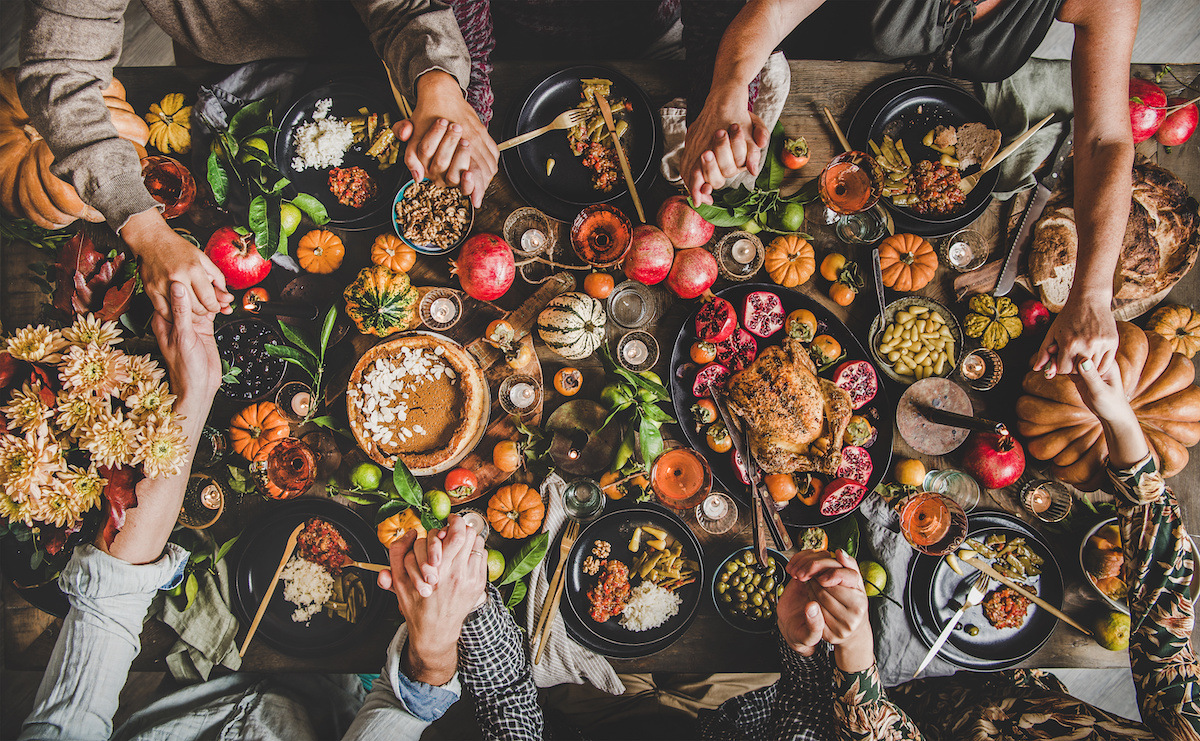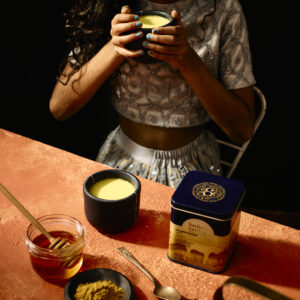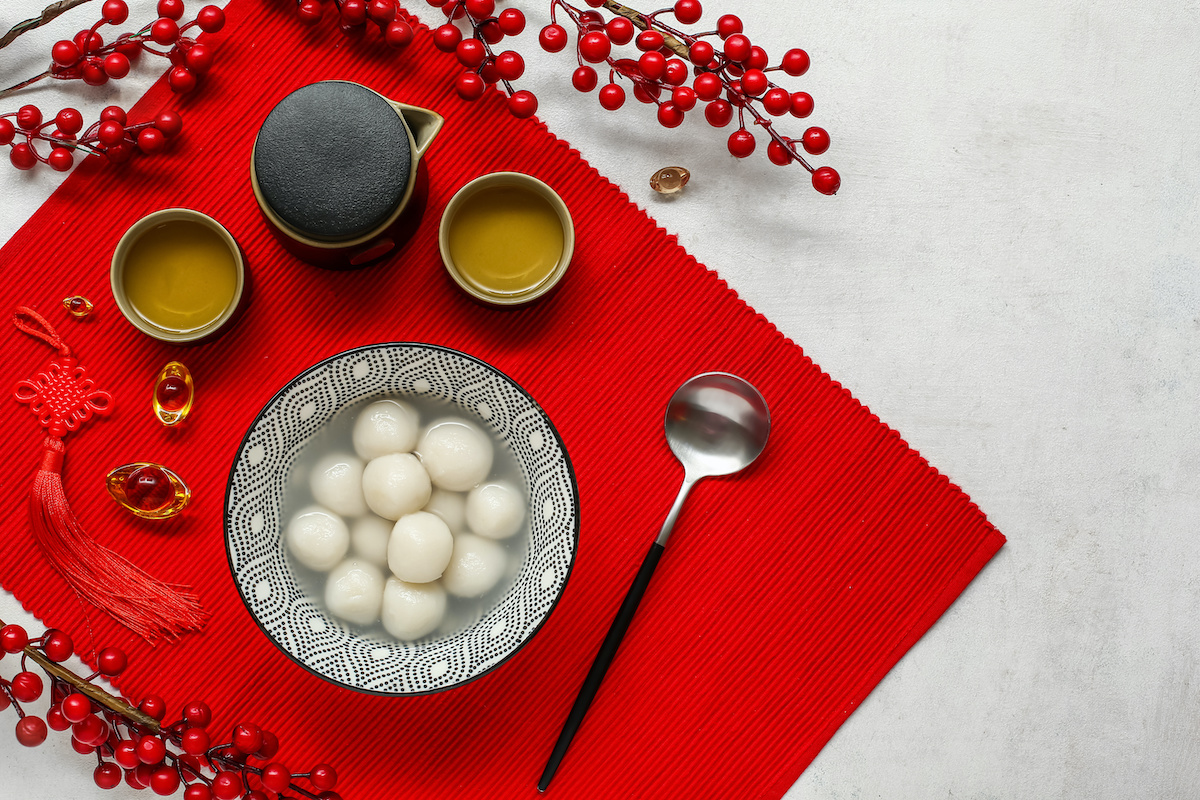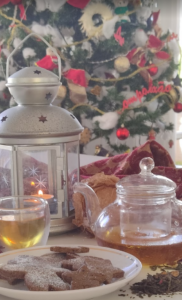
It’s that time of year when families gather for celebrations and festivities. So, we asked four of our writers to give us a peek into their traditions and rituals as we wind down the year. Jessica Natale Woolard writes about Canadian Thanksgiving, Elizeth van der Vorst writes about Christmas in Brazil, Poorvi Chordia writes about Diwali in the United States, and John Smagula writes about the winter solstice in China. – Aravinda
Baked With Gratitude: Pumpkin Cookies and Canadian Thanksgiving
By Jessica Natale Woollard
When the tips of leaves start to turn yellow and fallen chestnuts scatter on the sidewalks, it’s time to bake pumpkin cookies—because Thanksgiving is coming.
In the 1980s, long before the North American pumpkin-spice latté craze, my mother and a neighbor in our northern Ontario city found a recipe for pumpkin-oat-chocolate chip cookies in a women’s magazine. Every year since, my mom, sister, and I—now living in disparate areas of North America—have baked these delicious treats to herald in the fall season.
For my family, these cookies are synonymous with Thanksgiving, celebrated in Canada on the second Monday in October. The holiday’s purpose is to prompt citizens to pause with loved ones and give thanks for what we have.
The earliest account of Thanksgiving in Canada is from 1578; English explorer Martin Frobisher is recorded to thank God for surviving the journey across the Atlantic.
The story of Thanksgiving in North America also invites settlers and immigrants to give thanks to the Indigenous people who helped newcomers hundreds of years ago. In 2021, Canada introduced a holiday on September 30, the National Day of Truth and Reconciliation, in honor of the Indigenous children sent to Canadian residential schools, many of which were never seen again, as well as their families and communities. This new holiday’s proximity to Thanksgiving is fitting; it prompts people to reflect on the history and treatment of Indigenous people and then, two weeks later, contemplate all they have to be grateful for.
Like Frobisher, I gave thanks for safe passage this year. My husband and I traveled from our home in British Columbia to visit my family in Ontario. Upon arriving home, I raced to the kitchen, opened the black cookie tin, and took my first bite of pumpkin cookie. I chewed with a smile on my face. With one taste, the autumn had truly set in. With one taste, I was reminded of all I must be thankful for—family and health, love and safety.
In Canada, as in the United States, a traditional Thanksgiving includes a turkey dinner with cranberry sauce, stuffing, and harvest vegetables. Dessert is typically pumpkin pie.
Pumpkin pie is not essential to my Thanksgiving tradition. In my French-Canadian family, Thanksgiving dessert is often tarte au sucre (sugar pie) or pumpkin cheesecake. But for me, it’s the pumpkin cookies that make the holiday.
Our friends and family have come to love them, too. When young ones are around, we bake large versions, which kids decorate with icing, and add candies to make spooky faces.
Whether decorated with sugary sweets or left plain and simple, these pumpkin treats represent all the love of family baked into a soft, delicious cookie. Bite by bite, they remind me to be very grateful indeed.
Jessica's Pumpkin Cookies
Ingredients
- 4 cups unsifted flour
- 2 cups quick or old fashioned oats (uncooked)
- 2 tsp baking soda
- 2 tsp cinnamon
- 1 tsp salt
- 1.5 cups margarine
- 2 cups firmly packed brown sugar
- 1 cup sugar
- 1 egg
- 1 tsp vanilla
- 16 ounces solid-packed pure pumpkin (canned, but not a mix)
- 1 cup semi-sweet chocolate chips
Instructions
- Pre-heat oven to 350 F.
- Combine flour, oats, baking soda, cinnamon, salt. Set aside.
- Cream margarine and gradually add brown sugar and white sugar.
- Beat until light and fluffy.
- Add egg and vanilla to margarine mixture and mix well.
- Alternate adding dry ingredients and pumpkin to the margarine mixture. Mix well after each addition.
- Stir in chocolate chips. For small cookies, place spoonfuls of batter on a lightly greased cookie sheet.
- For large cookies, use two or three spoonfuls of batter and spread into a pumpkin shape.Bake for 20 to 25 minutes.
- To decorate: Make your favourite buttercream icing. Divide the icing and add different flavours and colours. Spread icing over cookies and decorate with candies.
Diwali: A Celebration Of Togetherness And Tradition
By Poorvi Chordia

Diwali, the festival of lights, is a time to savor life’s true bounty—delicious food, great tea, and the company of cherished family and friends. It’s a celebration of connection, honoring the relationships we hold dear while welcoming new ones. Each year, we mark this special occasion with a joyful gathering that includes not only our loved ones but also members of the Herbs & Kettles community—fellow small business owners, people from our local community and farmers markets, our photographer, and other creatives we’ve had the privilege to collaborate with. This celebration reflects the meaningful bonds we’ve built and nurtured over time.
As a dual-religion household, Diwali is a beautiful blend of traditions. Abe joins us in celebrating Diwali just as we embrace Christmas together. Our daughters especially love this time of year—they delight in wearing vibrant lehengas and adorning their hands with intricate henna patterns, connecting with their heritage in small but powerful ways. These rituals ground us in tradition while allowing us to reflect on our shared journey and the people who surround us. Diwali isn’t just a festival—it’s a chance to pause, reflect, and honor the friendships and love that make life meaningful, especially living as an immigrant in a city where friends have become like family.
Tea is at the heart of our celebration, embodying the warmth and hospitality Diwali is known for. We serve our Masala Chai, Golden Latte, and creative tea-based cocktails that add a festive flair to the occasion. Some of our favorites include a Rose Cardamom Chai with bourbon, a Hibiscus Twist Tea with mezcal, and a Lavish Blue Tea Mojito—each drink infused with the joy and creativity we pour into the holiday.
For us, Diwali is about embracing tradition while cultivating new connections. It’s a time to enjoy life’s simplest pleasures—delicious food, meaningful conversations, and shared laughter. With each cup of chai, golden milk, or tea cocktail, we raise a toast to the relationships that enrich our lives and the memories we create, knowing they’ll continue to warm our hearts long after the festival lights fade.
The Winter Solstice And Dumpling Tradition In China
By John Smagula
In China, many families gather to eat dumplings on the winter solstice (dongzhi), which falls on December 21. As the shortest day and longest night of the year, it is bitterly cold in many parts of the country. Yet from this cold and dark period, traditional Chinese dumplings were invented, now a favorite part of Chinese cuisine.

Legend has it that the 2nd-century sage of Chinese medicine, Zhang Zhongjing, visited a town around the winter solstice and found that residents were suffering from frostbite, especially on their ears. As ears are external organs, he understood they are vulnerable to frostbite and chilblain. To help the townsfolk, he set up a tent and boiled some minced lamb with foods known for their warming properties, such as scallion, ginger, and hot pepper. He encased scoopfuls of this filling in dough wrappers and served the crescent-shaped dumplings to the residents free of charge. Their frostbite was healed.
Thus, the dumpling was born, known then both as food and medicine. As dumplings are shaped like ears, the Chinese saying came about: “If you don’t eat dumplings on the winter solstice, your ears will freeze off.” Today, the tradition has evolved into many families enjoying a dumpling meal on the winter solstice.
For me, dumpling dinners have always been a lot of fun, especially when we gather to make the dumplings ourselves. Someone puts a bowl of filling on the table, and each of us gets our stack of wrappers to fill. The steamed or boiled dumplings, served with a pot of jasmine or pu’er tea, make the perfect combination for a warming meal on a cold night.
As days start to get longer after the winter solstice, eating dumplings that day marks the turning point from short days to longer ones, and by extension, that something good will come about from a dark situation. The Chinese idiom “out of the worst misfortune comes fortune” (piji tailai) is befitting for the season, as things always can change for the better.
In many parts of the world, winter holiday observances involve themes of victory of light over darkness. As Zhang Zhongjing rescued the frostbite victims from the worst, so can we face every difficult situation knowing there is a way out. May a bowl of dumpling soup this day mark a turn for the better in your life as well.
The Magic Of Christmas And Its Traditions In Brazil
By Elizeth van der Vorst
For me, Christmas holds a deeply Christian meaning and takes me back to my childhood, to a time when the true spirit of Christmas was felt in every detail. I will never forget the Christmas sounds, especially the bells from the church near our home announcing the midnight Mass. Families didn’t worry about going out late and always attended the holy Mass, keeping the tradition alive. Although the religious meaning still remains, today, I see fewer gatherings than before. Ah… so many good memories of the old Christmas traditions! Raised in a Catholic family and educated by the Sisters of the Sacred Heart of Jesus, Maria sisters, and the Salesians, Christmas has always been, for me, a celebration of the birth of Baby Jesus.
 Beyond the religious aspect, Christmas festivities were marked by the anticipation of gifts, a contagious excitement, especially among children. Friends, neighbors, and family gathered for Christmas dinner, which often took place before or even after Mass. The children, though sleepy, would not go to bed until they had seen what was under the Christmas tree, and this tradition of gift-giving still prevails today.
Beyond the religious aspect, Christmas festivities were marked by the anticipation of gifts, a contagious excitement, especially among children. Friends, neighbors, and family gathered for Christmas dinner, which often took place before or even after Mass. The children, though sleepy, would not go to bed until they had seen what was under the Christmas tree, and this tradition of gift-giving still prevails today.
Our Christmas dinner, which we still hold on the 24th, is no longer as late as it used to be. Churches now hold services earlier, around 8 pm, allowing families to organize their Christmas feasts. How can I prepare dinner without remembering those old family gatherings? I remember the drinks that graced the tables: the classic fruit punch with wine, the iconic Guaraná Champagne in glass bottles (a true Brazilian classic). And the sweets… custards, rabanadas… Oh, rabanadas! (Rabanada is a Portuguese sweet made from slices of wheat bread soaked in milk, wine, or sugar syrup, dipped in eggs, and fried or baked) A Portuguese treat that still cannot be missing from most Christmas tables.
Born in the South, where European colonies predominate, our Christmas dinners were enriched by typical Italian and German dishes like strudel, panettone, and butter cookies. But what brings back the most memories are the roasts prepared by my grandmother in the cozy warmth of the wood stove. And, of course, memories about my sweet mom who never failed to put dried fruits on the table: raisins, prunes, and dates, as well as apricots, in addition to natural fruits, such as pineapple, mango, watermelon, grapes, peaches, plums and oilseeds such as chestnuts (previously cooked) and walnuts and raisins, which were also always an ingredient for hot or cold dishes.

In the 1980s, it was common to visit the homes of relatives and friends after midnight, in a kind of Christmas “pilgrimage,” exchanging gifts and hugs. Over time, this tradition changed; globalization brought new ways to celebrate, and today, many prefer to spend Christmas at the beach or at parties with friends. For some families, the true Christmas spirit seems to be fading. But in my home, I make a point of keeping these traditions alive. I still prepare the nativity scene, waiting to place Baby Jesus in the manger, and Christmas dinner is always a special moment. Even though the family has become smaller, the heart still rejoices, knowing another Christmas has arrived.
Today, working with teas, I introduced a new facet to the Christmas table: mixology. I have been experimenting with dishes and desserts made with teas, such as delicately flavored cookies or bubbly drinks like an artisanal “champagne” made with Darjeeling tea. These creations not only bring new flavors but also add a special and unexpected touch to the celebration.
May this Christmas allow us to reclaim the true essence of the holiday, blending old traditions with new flavors and shared moments.
Tea Market
Get More Value from Your Tea: BRU Maker One
+41794574278
Jacque's Organics
(647) 804-7263
I enjoyed reading about these many holiday traditions. Thank you for sharing such intimate scenes. I look forward to baking the pumpkin cookies, having dumplings on Winter Solstice (though I think I really need them right now!), and discovering how to make Rabanadas. pw
Many thanks, and same here! It’s always a good time for dumplings. 🥟